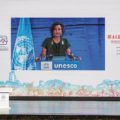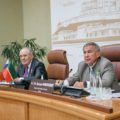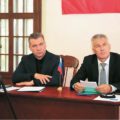The 44th session of the UNESCO World Heritage Committee (WHC) was held from July 16 to 31, 2021. Due to the bad epidemiological situation in the world, the session, which had been originally planned for Fuzhou (China), was held online for the first time in history.
The session of the WHC was an international event that included the participation of representatives from all member parties to the 1972 Convention on the Protection of the World Cultural and Natural Heritage, scientists and experts in the field, and two professional non-governmental organizations, the International Council for the Conservation of Monuments and Sites (ICOMOS) and the International Council for the Conservation of Nature (IUCN).
The Committee annually reviews reports on the state of conservation of UNESCO World Heritage Sites, inscribes new sites on the World Heritage List, and discusses issues related to the effective implementation of the provisions of the 1972 Convention. This year, the Committee reviewed 39 nominations for inclusion in the UNESCO World Heritage List, as well as reports on the state of conservation at 255 World Heritage properties, including 53 sites on the List of World Heritage in Danger. As a result, 34 new sites were added to the List, of which 29 are cultural and 5 are natural. Significant changes to the boundaries of three World Heritage sites were also approved. Currently, the UNESCO World Heritage List consists of 1,154 properties (897 cultural, 218 natural, and 39 mixed), including the most recent properties inscribed at the 44th session of the WHC.
During the session, a new site from the Russian Federation was inscribed on the
UNESCO World Heritage List. The Petroglyphs of Lake Onega and the White Sea are large, distinctive clusters of Neolithic rock art. They are some of the most fascinating sites in the Republic of Karelia. Surrounded by a particularly impressive natural landscape, these unusual, vivid, and mysterious rock paintings are well preserved and feature a wide range of themes.
The Karelian petroglyphs were the 31st Russian property to be included in the
UNESCO World Heritage List, further confirming Russia’s position as a world center of culture and demonstrating the dedication of the state to cultural preservation.
One of the most important events of the session was the transfer of the chairmanship of the Committee from China to Russia. During the event, Rustam Minnikhanov, the President of the Republic of Tatarstan, and Mintimer Shaimiev, State Counselor of Tatarstan and UNESCO Goodwill Ambassador, gave speeches, inviting delegates to the 45th session of the WHC, which will take place in 2022 in Kazan, Russia. In addition, the Committee approved the chairmanship of the Permanent Representative of the Russian Federation to UNESCO for the 45th session of the WHC, and also confirmed June 19–30, 2022, as the official event dates. Notably, the upcoming session in Russia will be held in conjunction with the 50th anniversary of the 1972 Convention.
The members of the 44th session of the UNESCO World Heritage Committee unanimously agreed to inscribe the Petroglyphs of Lake Onega and the White Sea of the Russian Federation on the UNESCO World Heritage List.
Two international forums were also held prior to the 44th session of the Committee. The World Heritage Young Professionals Forum under the theme of “World Heritage and Sustainable Livelihoods” took place from July 5th to 9th. In addition, the 4th UNESCO World Heritage Site Managers’ Forum under the theme of “World Heritage governance — Being prepared to manage change and continuity” was held from July 7 to 13.
The Young Professionals Forum was attended by representatives of 21 member countries of the UNESCO WHC. Round tables, master classes, and speeches by leading
UNESCO experts were organized for the event. The forum concluded with the preparation of a document that reflected the vision and approaches of youth for the preservation of world cultural and natural heritage.
About 100 managers from UNESCO World Heritage sites collaborated with the UNESCO World Heritage Center and the International Research Center for the Preservation and Restoration of Cultural Property (ICCROM) to discuss sustainable management and the promotion of the world’s unique monuments.
Artem Toporkov




